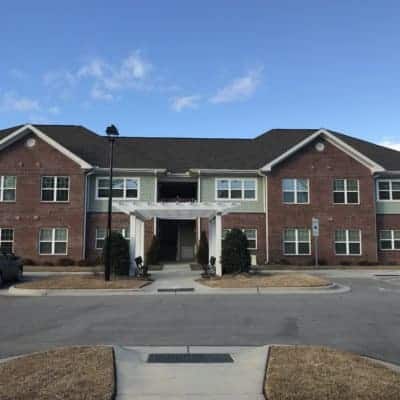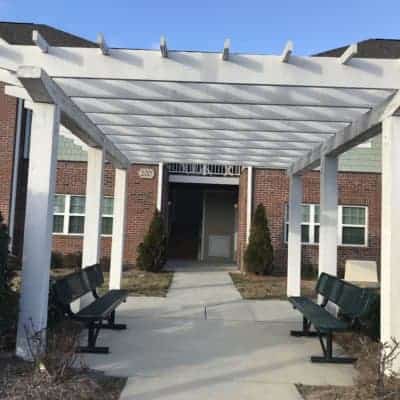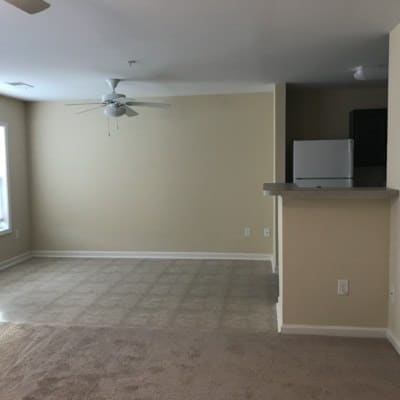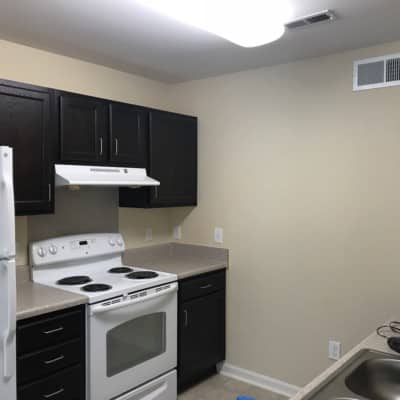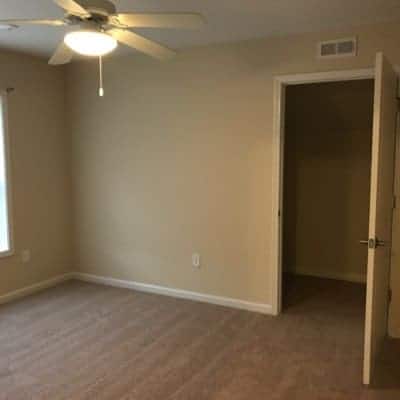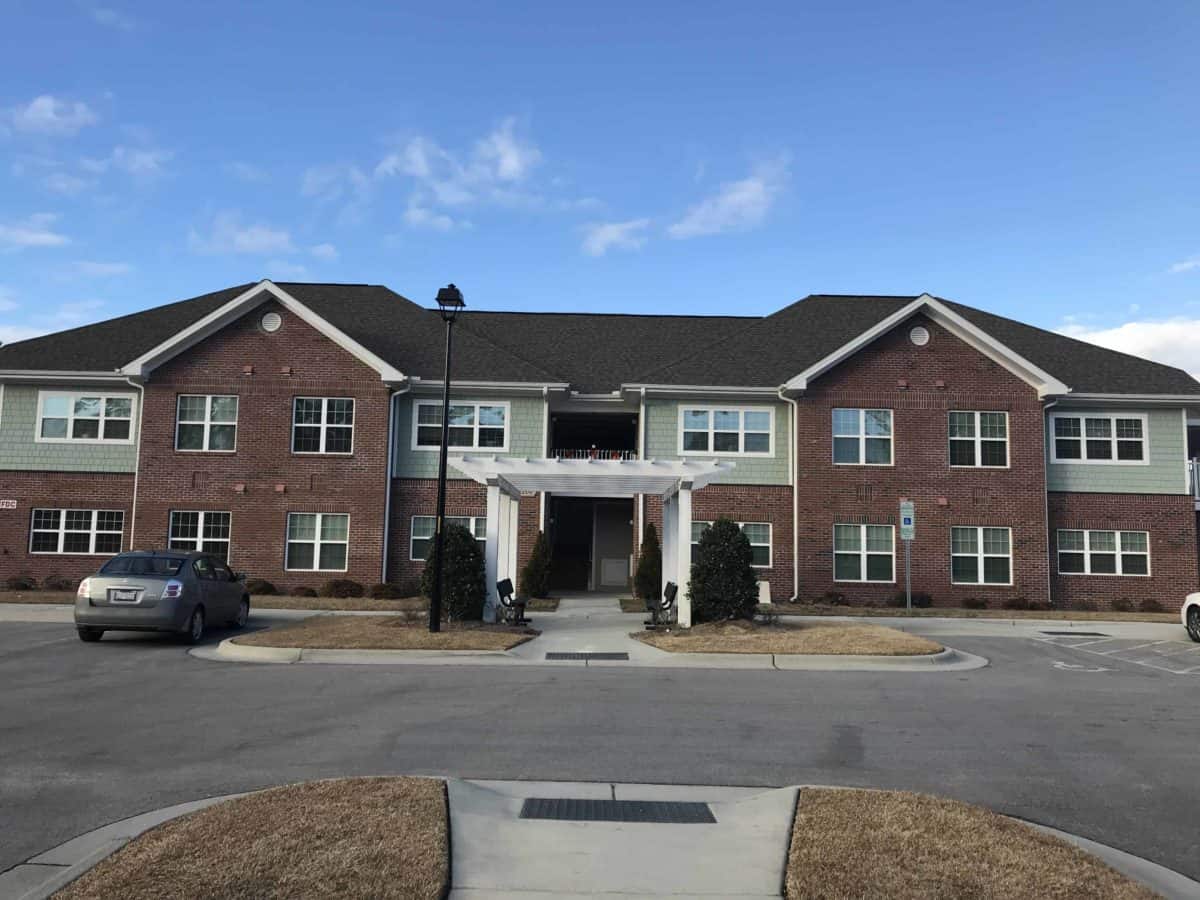

LeChae Johnson is a dance teacher at West Hoke Middle School. After working as a teacher’s assistant in Guilford County for four years, she decided she wanted to be a full-time teacher and got her masters in physical and health education. As a first year teacher, Johnson makes $35,000 a year plus a six percent salary supplement from Hoke County.
For Johnson, as for many teachers, housing costs are a large part of her budget. After getting the job at West Hoke Middle School in June, her principal told her about Echo Ridge apartments, an apartment building for teachers in Hoke County. Luckily, Johnson said, there was one apartment still available. She signed a lease in July and moved in a few weeks later.
Recruiting and retaining teachers are difficult tasks for many districts in North Carolina. While salary supplements are one solution, some districts are thinking outside the box for creative ways to recruit and retain talent.
Based on housing market analyses and surveys that revealed a lack of affordable housing, five districts in North Carolina built apartment complexes for their teachers. For three of them — Asheville, Dare, and Buncombe County — teacher salaries have not kept pace with rising housing costs, leaving many teachers unable to afford housing. In Hertford and Hoke County, there are few housing options for teachers who do not want or cannot afford to buy a house.
This report examines whether a lack of affordable housing contributes to teacher attrition in North Carolina and what some districts within the state and nationally are doing to address these concerns. Through our Reach NC Voices statewide survey of public school teachers, the majority (60 percent) of teachers who responded stated affordable housing is a barrier to teaching in their district. Almost half stated they are paying more than the recommended 30 percent of their income on housing.
To address these issues, five districts in North Carolina partnered with the State Employees Credit Union Foundation to build their own teacher apartments. These apartments provide a national model for how districts can combat a lack of adequate housing that is contributing to teacher attrition.


North Carolina’s teacher pipeline is an issue of much debate and concern. A 30 percent decline in enrollment in North Carolina’s public university teacher training programs from 2010 to 2015 accompanied by an increase in teacher attrition rates left many districts struggling to fill open positions. While enrollments have increased since 2015, overall teacher attrition rates for the state are still high. Some rural districts face attrition rates more than 20 percent.
According to the Department of Public Instruction’s draft 2016-2017 State of the Teaching Profession in North Carolina report, the overall state attrition rate was 8.65 percent. The LEA attrition rate for the state, which includes the state attrition rate of 8.65 percent plus the mobility rate (teachers leaving one district to teach in another district), was 13.45 percent.
A 2016 Learning Policy Institute report examined teacher shortages in the United States and found the majority of teacher demand is a result of pre-retirement attrition.
“If the attrition rate could be reduced from the current rate of 8 percent to 4 percent, closer to where it is in some other countries, U.S. hiring needs would decrease by around 130,000 teachers annually, cutting annual demand by nearly half. This large reduction would virtually eliminate teacher shortages and allow for increased selectivity in hiring, which could, in turn, boost the quality of teachers in the nation’s classrooms.”
Keeping teachers in the classroom not only benefits students but also saves districts substantial time and money in recruiting and training new teachers. Learning Policy Institute estimated that the cost of replacing teachers nationwide is more than $8 billion today. A study of the cost of teacher turnover in Granville County found that the cost of losing one teacher was $10,000.
It benefits districts to keep their teachers. However, there is rarely one solution that can lower attrition rates because teachers leave for many different reasons. The Department of Public Instruction breaks teacher attrition into different categories, including personal reasons, initiated by LEA, beyond LEA control, and other reason. In 2016-2017, 53.6 percent of teachers left for personal reasons, including 9.4 percent who left to teach in another state and 10.6 percent who left to pursue a different career. Of the 10.6 percent who left to pursue a different career, almost half were in their first five years of teaching.
Recent teacher pay increases are aimed at lowering the attrition rate by making it more attractive to teach in North Carolina, but even after these pay increases, North Carolina ranked 41st in teacher pay in 2016.
Local salary supplements— the amount that counties can add to teacher salaries—also figure into the debate on teacher pay. Urban districts with bigger tax-bases can afford to pay their teachers higher supplements than rural districts, creating a flow of teachers from rural to urban districts and exacerbating rural districts’ teacher attrition rates. Hover over the bars on the chart below to see the average teacher supplement by county.


To determine whether teachers in North Carolina struggle to find affordable, adequate housing, we sent a survey to 59,008 public school teachers in North Carolina in December 2017. Teachers from 88 districts participated in the survey.
Of the 709 respondents, 98 percent stated they were teachers and 2 percent were not. Those that indicated they were not teachers were directed to the end of the survey.
We asked teachers about their current housing situations, how much they are spending on housing, and whether they feel that a lack of affordable housing is a barrier to teaching in their districts. Sixty percent agreed that a lack of affordable housing is a barrier to teaching in their district, 25 percent were unsure, and 15 percent disagreed.
Sixty-one percent stated they would be more willing to teach in a district that provided affordable housing for teachers.
Federal guidelines recommend individuals should not spend more than 30 percent of their income on housing. In our survey, almost half (48 percent) of respondents stated they currently spend more than 35 percent of their monthly salary on housing.
Additionally, one respondent pointed out that some teachers may not have accounted for the fact that they are only paid ten months of the year, so the actual percentage of teachers who pay more than 30 percent of their income on housing may be higher than this.
Teachers’ current housing situations
Two-thirds of teachers in the survey live in a house (66 percent), with 23 percent living in an apartment, seven percent living in a condo, and four percent answering “Other.” Of those who selected “Other,” the most common responses were mobile home or trailer, town house, and with parents.
Forty-three percent of teachers surveyed live with a spouse or significant other, 25 percent live with family, 20 percent live alone, eight percent live with roommates, and three percent stated “Other.”
Forty-six percent of teachers surveyed own their house, apartment, or condo and 36 percent rent their house, apartment, or condo. Fifteen percent stated his or her family owns his or her house, apartment, or condo, two percent said his or her family rents his or her house, apartment, or condo, and one percent said they do not own and do not pay rent.
Some teachers reported living farther away from their school due to lower housing costs. Overall, 45 percent of teachers surveyed live 11-25 minutes from their school, 26 percent live 26-40 minutes away, 25 percent live 10 minutes away or fewer, six percent live 41-60 minutes away, and one percent live over an hour from their school.
Housing costs, among other factors, determine where teachers want to live
We asked teachers why they decided to live where they do currently. For some, a single factor dictated where they decided to live, such as caring for an elderly parent, but for most, many factors went into the decision. The most prominent factors influencing where teachers decided to live, in order of importance, were:
“It was the only thing available that was remotely affordable in a neighborhood I felt safe living by myself in.”
Housing cost: Almost half of the teachers surveyed mentioned the cost of their housing as a deciding factor in where to live. For some, rental or home prices dictated where they searched for housing, while for others, it was one factor among many.
“I want to live in the city and access the city’s best resources because it makes me a better Social Studies teacher.”
Location or neighborhood: The second most frequently cited reason for moving to a place was the location and/or neighborhood. Several teachers said they chose a location in between their work and their spouses’ work, while many cited access to cultural amenities.
“I liked the community. My community flows into the high school where I teach so I’m able to see my students outside of school.”
Proximity to work: Many teachers also cited the proximity to their school as a “driving” factor in their decision. Some teachers wanted to be part of the same community as their students while others stated a short commute as their main reason for choosing where to live.
“My parents are elderly, and they live here.”
Family: Several teachers responded they wanted to live close to family or had family responsibilities that determined where they lived.
“I have two boys and I wanted to give them the opportunity to have a good education.”
The school district: The quality of the school district determined where some teachers lived both for their own jobs and their children. Teachers with children stated the quality of the schools impacted their decision even if they taught in a different district.
“It is in the county I grew up in where I met my spouse.”
Hometown effect: Some teachers said they wanted to live where they grew up, which is why they chose to live where they do now.
“I have two small children and I have to think about their safety.”
Safety: Finally, many teachers mentioned the desire to live in a safe neighborhood as a reason why they chose their housing.


Stories of homeless teachers and teachers who can no longer afford to live where they work are garnering national attention. Urban school districts, especially along the coast, are dealing with affordable housing crises that are pricing teachers out of the district and contributing to higher attrition rates.
The map below shows the amount of income the average teacher needs to spend on rent to afford to live in major cities in the U.S.
In North Carolina, the average teacher needs to spend 27 percent of her income on housing in Charlotte and 24 percent in Raleigh.
The two most expensive cities are San Francisco and New York, where the average teacher has to spend 69 percent and 68 percent of her income on housing, respectively.
To deal with this problem, districts have embraced a number of different strategies. A 2017 report by the Donnell-Kay Foundation, “Affordable Housing Solutions for Educators,” presents case studies on two types of affordable housing for teachers — developer-led and district-led.
Developer-driven affordable housing for teachers
Developers from Newark, New Jersey to McDowell, West Virginia are investing in housing for teachers, often as part of mixed-use developments that include apartments, fitness centers, retail, and restaurants.
In Newark, RBH Group partnered with then-mayor Cory Booker to turn abandoned parking lots in downtown Newark into a Teacher’s Village. The development has 204 below-market rent apartments for Newark district, charter, and independent teachers as well as three new charter schools, 28 stores, and a daycare facility.
The $150 million development was financed through investors, subsidies, and loans, including Qualified School Construction Bonds, Redevelopment Area Bonds, Federal New Market Tax Credit, and New Jersey Urban Transit Hub Tax Credits.
Oxford Mills in Philadelphia, Pennsylvania, is a former dye factory turned apartment complex with offices for education-based nonprofits. D3 Real Estate Development used New Market Tax Credits and historic rehabilitation tax credits to make it possible to give teachers a 25 percent discount from market rent. Sixty percent of apartments are reserved for teachers with the other 40 percent of residents paying full market rent.
In both Teacher’s Village and Oxford Mills, as well as two developments in Baltimore, Maryland, developers chose not to use the Low Income Housing Tax Credit to finance construction because it would have restricted residents to those earning below 60 percent of the Area Median Income, which disqualifies teachers.
District-led efforts to provide affordable teacher housing
In many places, districts cannot afford to wait for private developers to create affordable housing for teachers. Instead, they are leading the effort by selling or leasing unused land to developers specifically for teacher housing or building their own housing.
Los Angeles Unified School District (LAUSD) partnered with the nonprofit developer BRIDGE Housing Corporation to build affordable housing for teachers on underutilized school property. Only after the lease was signed the lease and construction began did they discover that teachers would not be able to live in the apartments.
Because they used Low Income Tax Credits to finance the development, the apartments had to be reserved for those making 30 to 60 percent of the Area Median Income. Even beginning teachers made too much to qualify for the apartments.
Despite this initial setback, the apartments have proven valuable for district employees who make even less than teachers, including cafeteria workers, bus drivers, and special education assistants. Out of 156 units, LAUSD service workers rent 121 units.
San Francisco is the latest California district to tackle affordable housing for educators. In 2015, voters approved a $310 million housing bond, of which $80 million has been earmarked to build housing on district-owned land and to provide mortgage subsidies for teachers in an attempt to deal with skyrocketing housing costs.
Districts in Colorado are also struggling with rising housing costs. In Aspen, resort prices leave many teachers struggling to afford housing, so the district built 43 units of subsidized housing that rent for $850 to $1,500 per month instead of typical rents of more than $2,000 per month.
Legislative action in California
While some districts are working to address rising housing costs, states have taken little action to assist them. That changed when California passed the Teacher Housing Act of 2016. Facing a teacher shortage combined with rising housing costs, the legislature passed a law to incentivize districts to create affordable housing for teachers. The bill cited housing costs as a key factor in teacher attrition:
“A growing trend driving teacher turnover is the steadily increasing cost of housing in certain markets. In addition to the negative emotional and developmental impacts teacher turnover has on students, the costs borne by school districts to recruit, hire, and train new teachers each summer is immense. In San Francisco alone, during the summer of 2015, the school district had to recruit, hire, and train 700 new teachers. Many cited housing costs as the reason why the teacher was leaving the school district.”
The bill allows districts to use federal and state low-income housing tax credits for housing restricted to educators. Previously, federal and state tax credits could not used for housing that discriminated by profession.
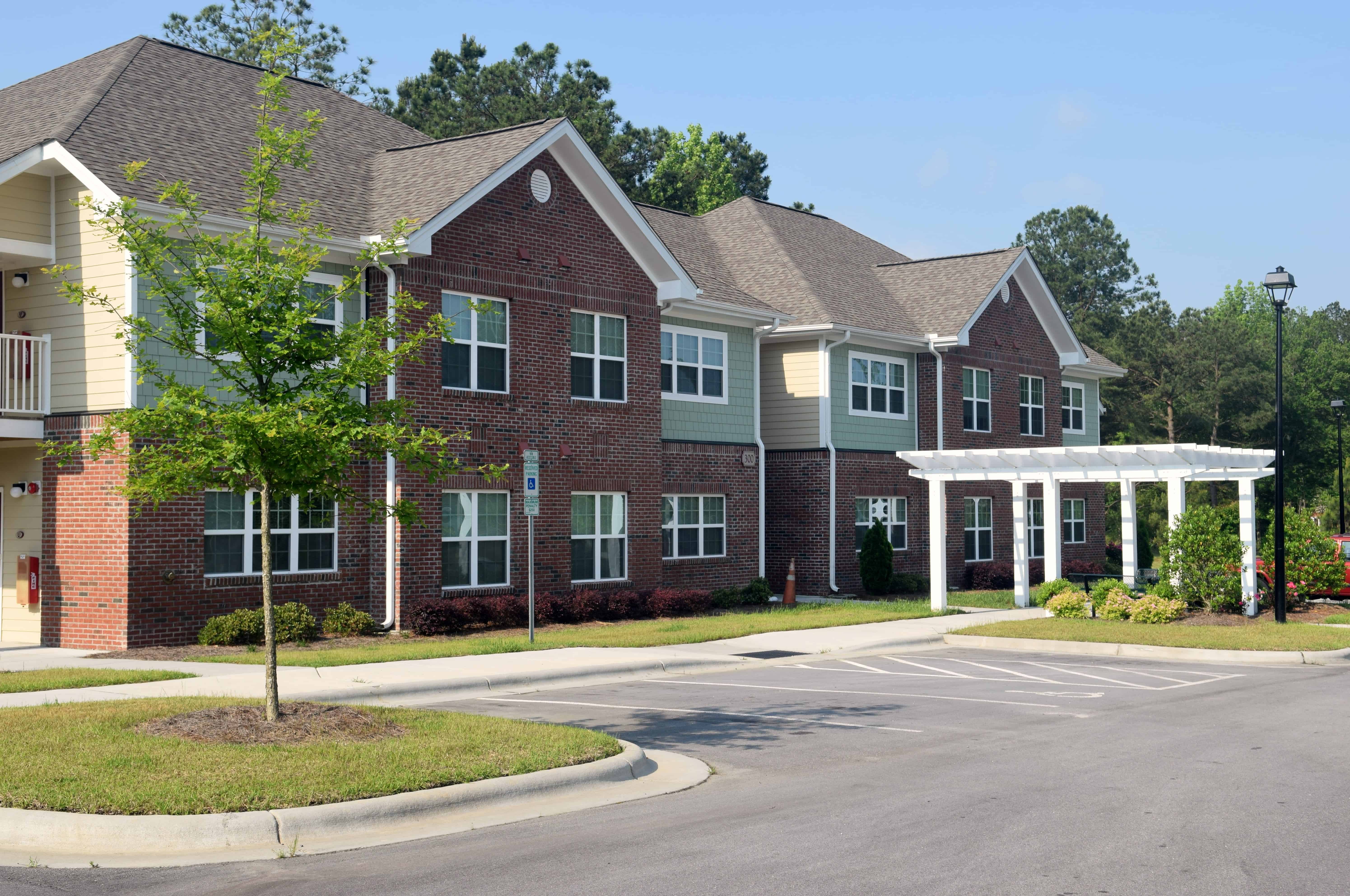

Five school districts in North Carolina have apartment complexes specifically for their teachers: Asheville, Buncombe County, Dare County, Hoke County, and Hertford County. Financed with the help of zero-interest loans from the State Employees Credit Union Foundation, the teacher apartment complexes contain two-bedroom, two-bathroom apartments that rent below market for teachers.
Hertford County opened the first teacher apartment building in Ahoskie in 2007, and Asheville and Buncombe County partnered to build the most recent one in May of 2017. Teachers and district employees alike tout the benefits of the teacher apartments, including below-market rent, fostering a sense of community among teachers, and serving as a useful recruiting tool for districts.
Hertford Pointe: The first teacher apartments in North Carolina
James Eure is excited. In three years, Hertford Pointe will have repaid its $2.5 million loan to State Employees Credit Union Foundation and the income from rent payments can be put back into Hertford County schools. He said, “After three years the mortgage will be paid off and then Hertford County Schools Foundation will have approximately $150,000 a year to support students in Hertford County. That will be so exciting.”
Eure is a senior vice president at State Employees Credit Union (SECU) and volunteer property manager of Hertford Pointe, a 24-unit apartment complex for teachers in Ahoskie. Hertford County is a small school district, only serving 2,768 students this school year. It is the second largest employer in the county behind Vidant Medical Center. Teachers receive an average pay supplement of $1,336.
The idea for teacher apartments in Hertford County originated from conversations between Eure, when he was president of the foundation board for the school system, and then-superintendent Dennis Deloatch.
“One of the biggest things we got out of talking with our new teachers was the fact that they didn’t have affordable housing. They could rent a house, but they didn’t want a house — didn’t want the upkeep of a home, and the electricity bills were high. They would come and go, and it was hard to retain a teacher in Hertford County because unfortunately it was either low-income housing or senior housing apartments. We found out after a survey that there were 21 or 22 apartments that somebody making a teacher’s salary could actually rent in Hertford County.”
Eure brought this to the attention of SECU’s president. At the time, SECU was just starting their foundation with the goal of promoting “local community development in North Carolina primarily through high impact projects in the areas of housing, education, healthcare and human services.” Helping districts build affordable housing for teachers aligned with this goal.
In 2005, the SECU Foundation approved a $2.2 million, 15-year interest-free loan to Hertford County Public School Foundation to build 24 two-bedroom, two-bathroom apartments for teachers, and in 2007, Hertford Pointe opened.
The rent started at $500 a month and is now $625. According to Eure, the majority of their teachers come from outside North Carolina and do not know the area, so the apartments are a useful recruiting tool. Once the district hires new teachers, Eure will lease them an apartment via email and have it ready for them when they move down in August.
“In the beginning it sounded good, but I would never believe someone would choose a school system because they have a place to live. Over the years I’ve been convinced.”
Because the rent is used to pay off the foundation loan, it is vital that the apartments remain full. In the rare year where Eure has an open apartment with no teachers to fill it, he opens it to local government agencies, other school system employees, and the sheriff’s department. Over the past 12 years, two deputy sheriffs and the chief financial officer of the local community college have lived in Hertford Pointe.
Eure attributes the success of Hertford Pointe to its location and lack of competition. Due to the lack of other housing options in Hertford County, there is always demand to live in the apartments and little competition from other rental companies. Over the past 12 years, Eure has met countless teachers in his role as property manager and is convinced of the value of teacher housing for both teachers and the school system, calling it a win-win.
Building affordable housing in a resort community
Dare County does not suffer from a lack of teachers who want to teach there — rather it is the opposite. Dare County is the easternmost county in the state and includes the Outer Banks. Dare County Public Schools is the largest employer in the county and serves 5,143 students this year.
Teachers are drawn to the district because of the desirability of living and working on the beach, but before 2008 they often could not afford to live there despite the average pay supplement of $4,081. Housing in Dare County is expensive compared to nearby counties due to tourism and the resort community.
School and community leaders visited Hertford Pointe and decided to try to convince SECU to finance teacher apartments in Dare County, not because they are a low-wealth district but because of their unique housing costs. SECU Foundation approved a 15-year interest-free loan for the construction of 24 two-bedroom, two-bathroom apartments modeled after Hertford Pointe. The apartment complex, Run Hill Ridge, opened in Kill Devil Hills in 2008, and in 2011, a second 12-unit apartment complex opened in Hatteras.
The Dare County school system and the education foundation, Dare Head Foundation, work together to manage the apartments. The Dare County schools maintenance team handles smaller maintenance issues and the Dare Head Foundation takes care of the larger items, such as replacing worn out appliances.
Rent for the two-bed, two-bath units is $750 a month, which Dr. John Donlan, director of human resources for Dare County Schools, says is a big recruiting tool.
“This whole community could use more affordable housing, period. People get sticker shocker here. If you look anywhere else in northeast North Carolina, you can get a whole lot more house once you leave the beach. [The apartments] are a strong recruiting tool. People see they could actually make a move here and there would be housing.”
Donlan says they currently have 100 percent occupancy, although it does fluctuate occasionally. After the Hatteras Teacher Housing apartments opened in 2011, they were having trouble filling both buildings with teachers, so they opened it to other government service agencies, including the Coast Guard and National Park Service.
Filling a need in Hoke County
Hoke County is located in the southeastern part of the state, just west of Fayetteville. Hoke County Public Schools serves 8,546 students this year and is the largest employer in the county. Teachers receive an average pay supplement of $2,472.
Hoke County has struggled with high teacher turnover. According to Sara Cagle, benefits specialist at Hoke County Schools, a lack of affordable housing meant that teachers were living in nearby counties and would end up transferring out of Hoke County. While there were houses for rent, the only apartments were low-income housing.
To address high attrition rates, Hoke County decided to build teacher apartments modeled after Hertford Pointe and Run Hill Ridge. They formed a local education foundation, Partners for Hoke County Education Foundation, and received land from the city to build Echo Ridge apartments. Sara Cagle and Miranda Roberts, a branch manager at SECU, co-manage the apartments.
The rent is $700 a month for the two-bedroom, two-bathroom apartments and is deducted from the teachers’ paychecks, so they do not have to worry about writing a check every month. Since Echo Ridge opened, they have largely been at full capacity with most teachers renewing their leases each year.
The apartments have been a huge recruiting tool, according to Cagle. Most new hires are not from the area, so they need more help finding places to live. Cagle is able to place many of them in the teacher apartments.
Teacher housing expands to Western North Carolina
The first teacher apartments in western North Carolina opened in May 2017 in Asheville. Two school districts, Asheville City Schools and Buncombe County Schools, partnered with Eblen Charities and SECU Foundation to build 24 two-bedroom, two-bathroom apartments that rent below market rate at $915 a month. The apartment complex is named the Williams-Baldwin Teacher Campus after Roy Williams and his wife Wanda, along with two other former Buncombe County teachers, Roy Eugene “Buddy” Baldwin and Rosa Lee Case Baldwin.
Asheville City Schools serves 4,416 students this school year with Buncombe County serving 23, 925 students. Asheville teachers receive a lower average pay supplement than Buncombe County teachers at $3,989 compared to $4,718.
Cynthia Lopez, director of human resources for Buncombe County schools, said teacher housing is something they have been talking about for 10 years because Asheville has become such a desirable place to live and vacation, resulting in higher housing prices.
Unlike Dare, Hoke, and Hertford County, neither Asheville’s nor Buncombe’s educational foundation wanted to take on the loan from SECU Foundation, so leaders from both school districts partnered with Eblen Charities, a nonprofit organization already working with both school systems. Buncombe County Schools donated land for the project, and the partners worked together with SECU Foundation to design a plan that worked for all involved.
Buncombe County and Asheville City Schools split the apartments based on number of teachers in each district, so Asheville City has six apartments and Buncombe County has 18. Then-superintendent of Asheville City Schools, Dr. Pam Baldwin, said it was one of the best projects she has ever worked on because “everyone around the table was really concerned about supporting teachers in a meaningful way.”
Baldwin stated it was a great recruitment tool for Asheville City Schools because affordability was one of the biggest concerns for new teachers. Additionally, the apartments help build community in the district:
“When you work in a school district where affordability of housing is a concern, it not only impacts the ability of teachers to afford to live there and teach. When your teachers do not live in the neighborhoods and communities in which they serve, there is a disconnect in partnerships and relationships you can build.”
Now that Baldwin is superintendent of Chapel Hill-Carrboro City Schools, she said she has reached out to SECU Foundation to start a conversation about affordable housing in Chapel Hill.
The unique role of SECU Foundation
Building apartment developments requires a significant investment, and as Los Angeles Unified School District found out, using federal tax credits to help with the financing can have unintended consequences. While districts have come up with creative ways to finance the development of teacher housing, in North Carolina, districts have a unique opportunity to finance teacher housing through interest-free loans from SECU Foundation.
SECU Foundation has a unique funding model, which program officer Scott Southern calls “the power of the dollar.” SECU members with a checking account are given the opportunity to provide one dollar a month to the foundation, and that combined dollar amount across the state gives them about $15 million a year to invest in projects like teacher housing.
For SECU Foundation, their main goal is to assist counties with teacher retention by addressing their housing needs. As a bonus, the counties then have a revenue stream to invest in their schools after they have repaid their loan. As Southern described, “When you are working with more rural counties, they don’t have capacity or access to donors or other funding. To be able to have a revenue stream that they wouldn’t have otherwise — that means that we are able to help the county twice.”


Each of the five districts agrees that the teacher apartments are a useful recruiting tool, but they are not a silver bullet. Many other factors contribute to a district’s attrition rate each year, including the number of teachers retiring. Teacher attrition rates for Hertford County fell below 10 percent in 2010 after opening Hertford Pointe, but they have since increased. Similarly, attrition rates in Dare County fell after opening Run Hill Ridge in 2008 but have climbed back up. Hoke County has the highest attrition rate of the five districts, something they are hoping to address with the teacher apartments.
District employees see these apartments as one factor among many that can convince teachers to come to their district. Both Southern and Eure emphasized the fact that housing is only one piece of the puzzle in keeping teachers. Southern stated,
“Affordable housing is just one of many factors that can influence teachers’ decisions to move to and remain in a county. County leadership is going to have address other factors that require community support and long range planning. These include access to recreation, dining, hotels, entertainment, and sports.”
Several other districts in North Carolina are hoping to replicate these teacher apartments. Last February, the Durham Public Schools Board of Education approved a proposal to build teacher apartments at the former Lowe’s Grove Elementary School site, and Eure has been talking to Bertie County Commissioners about helping them replicate Hertford Pointe in Bertie County.
Lessons learned for other districts
The first takeaway from the experience of districts with teacher housing is the importance of knowing the housing market in the area. As part of the loan application process, SECU Foundation asks each district to conduct a market analysis. This involves doing an inventory of housing in the county, looking at market rent for one-bedroom and two-bedroom apartments, and surveying teachers about where they actually want to live. Eure cautioned that districts should never assume that if they build it, teachers will come. They need to ensure there is a need by looking at the competition and soliciting teacher input.
Secondly, Southern stressed the importance of having community buy-in. County, school, and community leaders should be involved and actively encouraged to take a role in the planning and development process. For the apartments in Asheville, SECU Foundation involved the local steering committee in designing the building, something they had not done previously. They also encouraged the committee to hold a bidding process and invite local contractors to bid as a way to drive down construction costs.
Finally, SECU Foundation realized the importance of having a partner with real estate or property management experience to be responsible for oversight and management of the apartments. For the previous projects, the school districts and education foundations often relied on volunteers like Eure to run the apartments, but Southern said it can be hard to rely on volunteers, especially after the enthusiasm for the project has waned. In Asheville, Eblen Charities supervised the project and now serves as the property manager.
Are teacher apartments a worthwhile investment? This teacher thinks so.
Nate Adair is a health and physical education teacher at West Hoke Middle School in Raeford. In his fifth year of teaching, he is now also the athletic director at his school.
Adair grew up in Pennsylvania where he was inspired to become a teacher by his mom. “My mom made me want to be a teacher… Just seeing her relationships with other people and teachers and how dedicated she was made me want to be in this field.”
When Adair graduated from college, Pennsylvania was going through educational budget cuts and cutting back on art, music, and physical education classes. Knowing he wanted to be a health and physical education teacher, Adair applied to jobs in North Carolina. Hoke County Schools made him an offer and he accepted, liking the location since Raeford is close to bigger cities like Fayetteville and also the beach.
After he found out he got the job, he came down with his dad to visit and find a place to live. They did not have to look far. Adair’s principal told him about Echo Ridge apartments for teachers that were just opening, three minutes from his school. He got in touch with the property manager, Sara Cagle, and did a walkthrough of the apartments. Adair signed a lease and has been in the same apartment for the past five years.
Asked whether he thinks it is a good idea for districts to build teacher housing, he said:
“I do. I think it’s a positive recruiting tool, especially depending on the demographics of the county. It could draw some attention to them and at least get a teacher’s foot in the door. If I accept this job and they have housing for me already, or I could accept this other job, and I don’t know where I’m going to be living.”
What do you think? Should school districts build their own teacher housing? Share your recommendations for districts struggling with teacher turnover related to housing.




